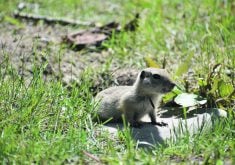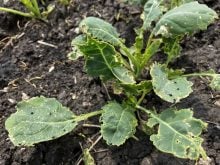Producers reminded to be aware of insects that prey on pests, particularly when spraying their crops with insecticide
When it comes to keeping fields healthy, producers are not alone.
Tyler Wist wants producers to realize as they work to deal with pests in their crop that they have some heavy hitters from the natural world in their corner.
Wist and the Western Grains Research Foundation’s Field Heroes program is working to promote bugs like lady beetles, syrphid flies, damsel bugs and many other bugs, as a way to help producers with pest control.
“The Field Heroes campaign is trying to sing their praises and make growers and agronomists aware of what they look like and potential they have to control pest insects in their crop,” says Wist.
Read Also

Growing garlic by the thousands in Manitoba
Grower holds a planting party day every fall as a crowd gathers to help put 28,000 plants, and sometimes more, into theground
The so-called field heroes, or beneficial insects, work as predators to detrimental pests that feed on producers’ crops, acting as another tool of pest control for producers.
And according to Wist, there is a parasite for every kind of detrimental pest. There are even parasites that feed on other parasites, he says.
These field heroes are interesting because they lay eggs inside the host and when the eggs hatch, the babies have a living food supply.
“Gruesome way to go, but fun when you’re thinking of them as field heroes,” says Wist.
There are so many pests and field heroes that Agriculture Canada has put out a scouting guide that producers can use to identify which is which.
Scouting is important when producers are looking for bugs in their field with most of the bugs spending time in the canopy.
The best way to scout is with a sweep net and a container with a white background to give producers a good look at which bugs they have. While the beneficial bugs are great to see, they can also mean other intruders are present, says Wist.
“If you’ve got some of these field heroes in your field, there’s a good chance that you’ve also got the pest insect they’re eating in your field.”
A lot of lady beetles, especially larvae, mean a whole lot of aphids, says Wist.
Ground beetle scouting can be a little more difficult, he says, but in his line of work, they use pit fall traps where bugs fall in and can be counted.
Even with predatory insects helping with pest control, Wist says producers cannot let them do all the work.
If producers need to spray their fields, they need to spray, but there are ways of helping their friends out.
The label will say whether a pesticide is safe for beneficial insects and will provide the proper times to spray.
“The label is pretty good at telling you when to apply to protect those field heroes.”
Parasitic wasps are nectaring when canola is flowering, as are beneficial pollinators, so producers must take that into account when they decide their spraying schedules.
Some field heroes will take some time to appear in relation to when their prey starts to hatch.
Wheat midge, for example, appears long before their parasitic predators appear, so Wist said that producers must give their friends some time.
A scouting guide is available through fieldheroes.ca and through Twitter @FieldHeroes.

















